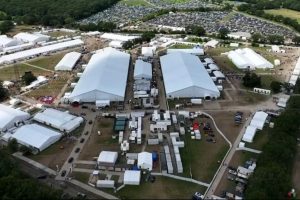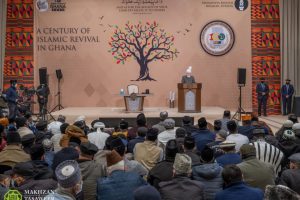The Shroud of Turin has been a source of fascination for the academic world for hundreds of years. The ‘alleged’ burial cloth of Jesus Christ (as) has stirred numerous controversies and continues to home inexplicable mysteries. The Review of Religions held its fifth exhibition during the Annual Convention of the Ahmadiyya Muslim Community. Professor Bruno Barberis, the former President of the Scientific Committee of the International Centre of Sindonology of Turin, talked about the Shroud and answered some unresolved questions.
‘This is a historical moment. He said. We are currently living in the era wherein people are less inclined towards religion. Hence it is our duty to convince them of the importance and the value this sacred item holds.’

He went on to explain that in 1898 Secondo Pia, known for taking the first photographs of the Shroud[1] laid the foundation for the event that led to the beginning of the study and research into this historical object. The pictures revealed remarkable insight into the enigmatic cloth itself. The Shroud behaved like a natural photographic negative imprint with the exceptions of blood stains and marks and disclosed a detailed image of the man in the Shroud. Bruno expounded on two fundamental questions pertaining to the aforementioned item. Firstly, is the imprint really left by the human body or is it a forgery fashioned by an artist with the help of certain techniques? Secondly, is it possible for a corpse to leave a similar image on the fabric in a natural way; moreover, through what process could that have been achieved?

He disclosed that with the Shroud imprint we can easily identify the areas of the fabric on which the image of the human body, frontal and dorsal, is visible. The image is without a contour and is extremely superficial. An analysis conducted in 2002 only confirmed the hypothesis. It revealed a baffling detail, the absence of the body image at the back. There had been several attempts to replicate the image, all but in vain. During the last century doctors carried out numerous experiments using canvases soaked in turpentine and oil solution sprinkled with the mixture of aloes and myrrh. However, the results proved unsatisfactory. In 1981 after exhaustive study and evaluation, a group of scientists from American Association STURP [Shroud of Turin Research Project] concluded that no pigments, paints or dyes have been found on the fabric.
The research done by STURP which Professor Barberis speaks of issued their final report in the following words:
‘We can conclude for now that the Shroud image is that of a real human form of a scourged, crucified man. It is not the product of an artist. The blood stains are composed of haemoglobin and also give a positive test for serum albumin. The image is an ongoing mystery and until further chemical studies are made, perhaps by this group of scientists, or perhaps by some scientists in the future, the problem remains unsolved. ’ [2]
Professor Barberis further revealed the Ultraviolet and infrared evaluation also confirmed these studies. Micro chemical evaluation has indicated no evidence for any spices, oils or any biochemical known to be produced by the body in life or death. Hence it is evident that the body had been in a direct contact with the Shroud which explains certain features such as scourge marks and the blood. Therefore, the consensus is that the image was produced by something which resulted in oxidation, degradation and conjugation of the polysaccharide structure. There is no chemical or physical method known today which can account for the totality of the image. Nor any physical, chemical or medical circumstances explain the image adequately thus the answer to what produced the image or how it was produced remains the mystery to this date. Some scholars have also hypothesised that the image could have been formed due to the interaction of the cloth with radiation or soft ultraviolet rays, laser beams, nuclear radiation and neutron and proton flows.
Professor Barberis unveiled that another important contribution was done by computer processing. In 1976 two American scientists John Jackson and Eric Jumper used VP-8 image analyser[3] [an analogue computer that uses the isometric projection technique to convert image density into vertical relief] to process the computer image in a unique three-dimensional way which paved the way for future research. However, to reach a decisive conclusion we need fresh approach and modern techniques.

Referring to his second question, Professor Barberis discoursed that the blood stains are microscopically characterised by a complex system. The colour varies from side to side from brown to red to orange. If you look closely at the microscopic picture of the fabric you would find the traces are clearly visible. They have penetrated the fibre because blood is fluid and it permeated its way to the back as well. It is important to know that no body image traces were found where the blood was present. First, the blood was spilled on the sheet and then later the image was formed. John Heller confirmed the presence of iron and calcium through micro chemical reactions and rejected any notion that supports the presence of any elements containing inorganic pigments.
As we delve further into John’s research we are able to verify his stance on the Shroud and affirm Professor Barberis’s account of his work. John seems adamant and posits firmly in the following words his opinion of the blood:
‘When with 100 percent certainty, we make a categorical statement that blood is present, believe it! ’ the biophysicist went on to say. ‘I have tested for the presence of blood in capital cases for the prosecution and defence. If I had found blood on two samples and one turned out to be Swiss cheese and the other a moon rock, I should, with confidence, tell the authorities to look for a gory dairyman or a wounded astronaut.’ [4]

Professor Barberis added that a number of tests in 1978 from the so called black areas of the Shroud lead the scientists to deduce that the blood stains belonged to the human blood type of AB. Another one asserted that the blood flow patterns were unrealistic. They were either an artistry or fake. However, these experiments presented several limitations. Firstly, the experiments were conducted on a living and a healthy human being without traumatic wounds of any kind. Secondly, several other variables, like hair on the skin, humidity, temperature, movements and muscle contractions etc. were not taken into consideration. Also, they used a blood with anti-coagulant which was a lot different from a person who was crucified and whose blood was already pathological due to the bleeding and suffering. Therefore, the conditions were totally different and their conclusion cannot be scientifically accepted.
A similar experiment was carried out by John Jackson, a physicist who was part of the 1978 scientific team that conducted test on the Shroud, which confirmed the realism of the blood flow on the pattern of the Shroud.
So in the end it all comes down to the fact that we ought to have a new collection of data and start again from where we left in the first place, that is to say, the result of the 1978 analysis. Perhaps, this is the only method that could ensure a concrete progress in the future.
[1] https://www.historychannel.com.au/this-day-in-history/shroud-of-turin-first-photographed/
[2] https://www.shroud.com/78conclu.htm
[3] https://www.shroud.com/78strp10.htm
[4] https://www.washingtonpost.com/archive/lifestyle/1983/07/17/mystery-of-the-shroud/59734457-b1f3-4ba0-9262-80a7eef3a35d/
…………………………………………………………….
…………………………………………………………….




Quote from article: “‘This is a historical moment. He said. We are currently living in the era wherein people are less inclined towards religion. Hence it is our duty to convince them of the importance and the value this sacred item holds.”
My reply: The Shroud of Turin, along with the following sign from God, should be significant evidence that His word is truth. See the following:
Video – God put His name in the mountains of Jerusalem
Jerusalem – I Will Put My Name There – Amazing Revelations
https://www.youtube.com/watch?v=aZO_eRmR2ho
and
HaShem’s Name engraved on the Mountains of Ephraim (Israel) North of Jerusalem
https://destination-yisrael.biblesearchers.com/destination-yisrael/2011/09/hashems-name-engraved-on-the-mountains-of-ephraim-israel-north-of-jerusalem.html
How much more evidence is needed to convince skeptics that God exists now and has always existed since the beginning of time?
Best,
Tamara Beryl Latham